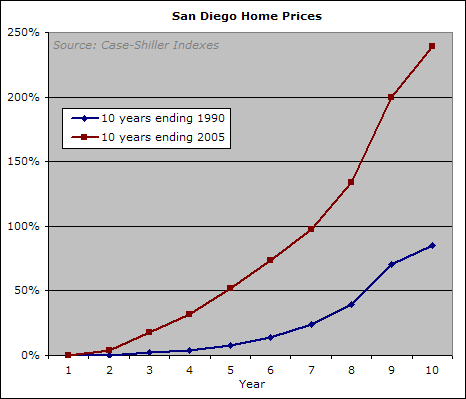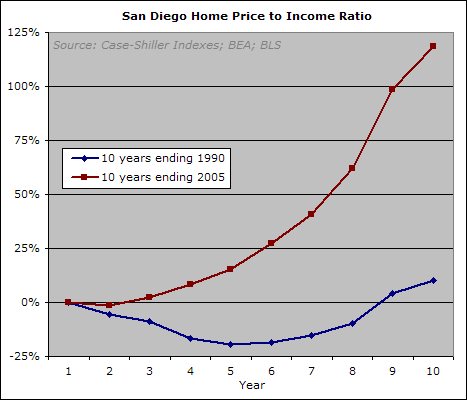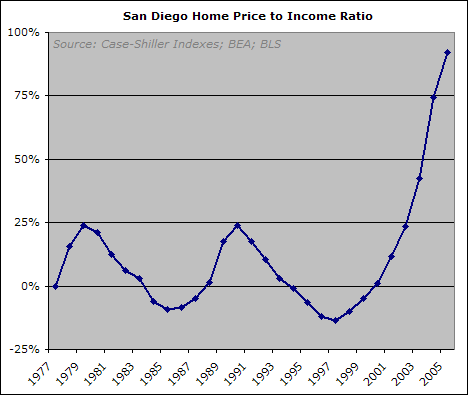This week’s voiceofsandiego.org article actually deals with the mother of all housing myths: the beloved "soft landing" that most people apparently consider to be in the bag.
Part of my argument rests on the fact that the current housing boom has made prior booms look absolutely feeble by comparison. The following graphs from the article (utilizing the Case-Shiller home price index, which doesn’t track medians but rather tracks the estimated appreciation of the typical single family home) demonstrate the extent to which this is true:



Using the aftermath of prior booms as evidence for an impending soft landing is fairly flawed, especially considering some of the other risks facing the market. (But those will be covered next week). Check out the article for more thoughts on the matter.

Rich, I’ve always loved your
Rich, I’ve always loved your graphs, and that middle one there really takes the cake. It shows quite graphically (I didn’t intend that pun, but if I did, I wouldn’t admit it) just how much this housing boom dwarfs the last. I guess it’s the same info as in the last graph plotted differently, but somehow it’s more impressive.
Nice graphs but i would
Nice graphs but i would prefix the graph titles with “Percentage change from Base Year in ….” (if I understand them correctly) to help the reader. Also I thnk that including data for 1990 to 1995 in the first two graphs would add value
Keep up the good work.
I would also consider
I would also consider normalizing to or overlaying a graph of the prevailing interest rates at the time.
PIMCO:
We’ve looked at
PIMCO:
We’ve looked at housing bubbles over the last couple of hundred years and one thing that was very consistent and I think was really clear is that bubbles only burst when there is a lot of unemployment. If you just look at the last 25 years, there are two examples of housing bubbles that burst. One was in California in the early 1990s, when virtually the entire defense industry got laid off and there were 20 for-sale signs on a block. The other big case was the Texas-Louisiana oil patch problems of the 1980s where you had 35% unemployment regionally.
UCLA Anderson Forecast echoes this view: housing prices only bust during recessions, when people are unemployed. As long as people have jobs, they’ll pay the mortgage. You need 2 sectors to lose jobs for a recession. They expect large job losses in construction, but no other sector has job losses. Maybe some realtors, but their job losses will be more than made up by high paying jobs in professional and business services, which are increaseing 1.5% annually.
These folks have left out a lot of stuff. I’m working on an analysis of the UCLA report, and will post a thread next week. There are many weaknesses and omissions in their analysis!
The first omission that
The first omission that comes to my mind is that 40% of the new jobs in the last 5 years are real estate related (granite counter-top installers, condo sign flippers, assistant loan brokers, real estate assistants, escrow agents, title officers, appraisers, etc, etc, etc).
In my opinion, most of those jobs are toast in the next two years as people realize that the real estate market has died.
And those new “high paying jobs” won’t be coming to San Diego because companies don’t want to pay enough in wages to cover the cost of living in San Diego. Why would a business person locate a services company in a high cost city like San Diego? There are lot’s of smart people in other parts of the country where entry level houses don’t cost 500K. And what about all those English-speaking people in India? Service jobs are going to stop leaving the country all of the sudden?
I will agree with them that we aren’t at the “20 for-sale signs on a block” yet. On my street there are “only” three houses and two condos for sale. Several of these properties have been on the market for months. Two of the houses and one of the condos have been reduced in price. Will we reach the “20 signs per block” level by this summer? Driven through Clairemont or Pt Loma lately?
Powayseller, I look forward to your follow up on the Anderson forecast. (and glad to see your posts again)
I agree that the issue of
I agree that the issue of growth in employment in the RE sector is a big problem. People are already seeing reductions here in OC with the lenders. This whole thing has fed on itself, which is more dangerous than if it were the result of a combination of things.
Just because bubbles have
Just because bubbles have burst in the past only when there was high unemployment doesn’t mean it must follow that same pattern every time. The circumstances we have now, with so many loans resetting in the next few years, are unprecedented. I will not be surprised if the housing correction leads to high unemployment and recession here in So Cal, vs. a recession causing a housing correction. More likely they will feed each other.
Yes, it is different this time. We have not had these crazy loans helping to fuel past housing booms. I might be willing to entertain the idea of a “soft landing” if we didn’t have these loans. In an ideal scenario, where everything just stayed the same, it could happen. But things will not stay the same; we know that ten’s of thousands of homeowners in San Diego will be seeing their loans reset over the next few years, in many cases having to come up with an extra $1000 or more per month.
I am surprised, as are others here also, that the UCLA Anderson people seem to be going along with the “soft landing” scenario. The hoped for “soft landing”, along with the belief that we’ll only experience a correction if there is high unemployment and recession, is the only thing that non-believers of a correction have to comfort themselves with right now.
It’s hard to look at these graphs here and not rationally come to the conclusion that we’re in for a significant correction. It is still early, we haven’t seen anything yet.
The past does not repeat
The past does not repeat itself, but it rhymes.
– Mark Twain
This is a retro-landing, not
This is a retro-landing, not a crash. Looking at the third graph, we should expect a nice soft landing from 2003 and on. Never mind the little blip for 2004, 2005, and 2006. It’ll be nice and soft landing to the 2003 levels. Who says that’s a crash?
What has propped the market this far:
1. 500k tax deduction
2. Low interest rates
3. Herd mentality
4. Low unemployment
Now that the effects of the first three legs are gone, I doubt unemployment can hold up this table much longer.
I have no doubt that there
I have no doubt that there will be corrections in the market. However, I suspect that such corrections will be far from uniformly spread across the entire marketspace.
Here’s an example of what I’m talking about. In Austin, Texas in Jan-Apr 2001, there was a huge event. Thousands (as I recall around 20,000) high-tech workers lost jobs in the area as IBM, Kodak, and other major employers had to cut staff due to the tech bubble burst. The upper end of the real estate market went into FREE FALL. I mean it. It was a disaster for folks who purchased properties in the 50+ percentile price sector of the market.
HOWEVER, at the bottom end of the market, there was virtually no decrease in values, and in 2001, as I recall, people in the bottom 10-20 percentile price sector actually saw slight increases as there was huge market pressure to enter at the bottom level due to the uncertainty at the mid and high levels.
I thought this was a most instructive lesson for investment, i.e., that investing at the bottom end of the market is surely the safest place.
Has anyone done any analysis on how the downward momentum will affect different price and geo sectors? My suspicion is that the market sectors that will draw the biggest drop are as follows: markets where there are large developments in process (e.g., San Elijo Hills), markets that have less inherent weather uniqueness (e.g., inland locations like Fallbrook, Temecula, Escondido, etc.), and high-end market segments (e.g., >$1M). But those are my suspicions based on observation unsupported by hard data. Does anyone have any hard data on this question?
If the distribution is not going to be equal, then it is REALLY important to identify the largest downside risks because many people (e.g., families?) moving to the area really do want to buy, but they want to do risk minimization. I DO advise people of the risks of buying right now, but if they intend to buy, then the second most important thing to assist them with is risk mitigation. Anyway, I’d be interested to hear if anyone knows of research in this regard.
FINALLY, here’s a question that I’ve been thinking about for the last 6-7 years since I started studying the data on global warming. (Note: For this discussion, I think it is irrelevant as to whether GW is manmade or a natural event.) It would seem to me that global warming WILL have a powerful effect on real estate values. Most notably, areas that are already hot that will get hotter will become far less desirable. Also, areas with risk of weather-related damage (e.g., coastal Florida) could also see decreases. Areas like coastal San Diego that can suffer an increase in temperature and still be most pleasant and that have low risks of weather damage SHOULD see quite an increase in popularity. Real estate may be expensive, but if you’ve got the cash and you live in the mid-west which is going to start broiling, maybe San Diego is still the place to come to retire. Over the past 20 years, we’ve seen the Sun Belt grow in popularity…here’s my point….there are places in the Sun Belt, like San Diego and high elevation locations (e.g., Santa Fe?) that may gain a disproportionate share of the next migration. Does anyone know if any analysis has been done along these lines?
John Hokkanen